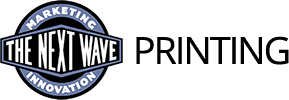Helpful Print Terminology:
Aqueous coating: A protective coating that is less expensive than varnish—it is water-based and dries quickly. It provides scratch and smudge resistance and is high-gloss.
Bond paper: A standard, high quality paper used for most print jobs.
Bleed: Most printers are not capable of printing to the edge of a sheet of paper. Prints that require ink to the edges of a printed page must be printed on a larger sheet of paper with extra room to be trimmed to a final size. This extra area is called a “bleed.”
CMYK: This stands for Cyan, Magenta, Yellow, and Key (also known as Black). The type of printing that uses these four colors is also called “4 color process.”
Crops: Marks that show where a print job should be cut.
Direct mail: Postcards or other media that are mailed to a target market.
DPI (dots per inch): The resolution (clarity) of images is made up of how many dots are in a square inch. Screens (television, computer, mobile phones) have a standard 72 DPI, and printed materials have at least 300 DPI. This is the reason that photos and other materials that are taken from the web do not always print as clearly as they are seen on screen.
Folds:
- Accordion fold: A fold that goes back and forth, not overlapping.
- Gate fold: A fold that contains a “middle” section and two side panels that fold inward.
- Half fold: A fold with only one crease in the center, creating two panels.
- Tri fold: A fold with two creases, creating three panels that overlap.
- Z fold: A tri-fold that does not overlap (the folds do not fold toward each other, but in opposite directions).
Gloss finish: A coating on paper that allows for a highly-reflective appearance. This coating also reduces ink absorption into the paper, so colors appear more vibrant and with more contrast and definition.
Ink Jet: A type of printing in which ink is applied by nozzles in the printer—some kinds of coating cannot be applied to prints produced by ink jet printers.
Pantone colors: The universal color matching system that assigns a number to thousands of colors. The PMS (Pantone Matching System) was created so that colors can be recreated on any printer and look the same. Colors that are not printed using a PMS color (therefore using CMYK values) are likely to be different when printed on different printers.
Perfect binding: A kind of binding that allows the binding to be hidden from readers.
Ream: A quantity of 500 sheets of paper.
Registration: The lining up of layers in a print job. It can refer to the 4 colors lining up with each other, or the back and front of a page lining up against one another.
Resolution: The clarity of an image on screen or on print—the higher the resolution, the higher the clarity. Resolution is created by how many dots are contained within a square inch (DPI) of the image.
RGB: The colors that are used to produce an image on screen—red, green, and blue. Light is produced by screens (think of all the times you’ve used your cell phone as a flashlight). The eye will always perceive color differently on-screen than it will when viewing a CMYK (printed) image.
Safe Zone: The area of a printed piece where designers leave plenty of room between the important information and the cut line.
Score: The crease that is created so that folds may happen without sacrificing the integrity of the paper.
Signature: The collection of 16 pages that are bound together to create a part of a book. The signatures are then bound to one another to create the whole book. Many book jobs must contain a certain number of pages to create signatures.
Spot coating: When a print finish is applied to certain areas of a print job so that those areas stand out. The reflective (shiny) quality that spot coating produces can be applied to logos or any other image or text.
Text paper: A textured, uncoated paper that is available in different thicknesses.
Trapping: Some printers are capable of trapping, or printing one ink on top of another ink—the color is therefore exponentially more rich and vibrant.
UV Coating: An environmentally-friendly coating used in printing for its economy. It is liquid laminate that is bonded and cured with ultraviolet light.
Varnish: A protective coating that is applied to printed pieces—it can be matte or glossy. It may serve as an all-over coating, or can be applied to certain parts of a printed piece to help that part stand out.
